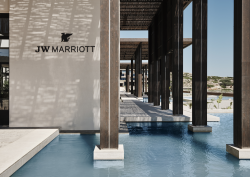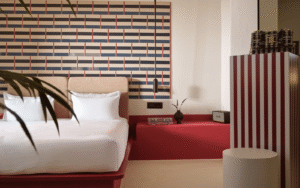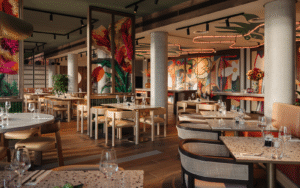Highlighting the recently completed project in St. Regis Hotel in Cairo by the Michael Graves studio, Yurasek takes a deeper look at thoughtful approaches to designing for authentic and immersive hospitality journeys…

In the face of increasing standardisation in hospitality experiences, design visionaries such as Julie Yurasek, International Director of Interior Design at Michael Graves Architecture, are leading a movement that prioritises the creation of authentic and immersive journeys for guests by involving local artisans in the design process.
Yurasek’s commitment to enhancing travelers’ curiosity and capturing the true essence of a destination is evident in her emphasis on collaboration. Working closely with local artisans, she forges a meaningful connection with the community while supporting its economy and preserving its cultural heritage. This thoughtful design approach transforms each project into a canvas that showcases the craftsmanship and pride of local artisans, enveloping guests in an authenticity that transcends mere aesthetics. We caught up with the designer to continue the conversation…
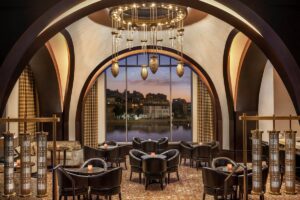
Image credit: Ralf Tooten / Marriott International
With traveller priorities shifting, according to a study conducted by travel booking platform GetYourGuide, 51 per cent of leisure travellers say experiencing their destination as a local is a high priority. Additionally, the study also found that 45 per cent are concerned with not having an authentic experience –– with a majority 67 per cent of travelers expressing they’re not willing to cut spending on accommodations. It’s clear the built environment plays a critical role in meeting these expectations when it comes to fostering a genuine connection with the destination.
These statistics not only indicate a trend, but an enduring principle that guests have consistently desired in recent years. Immersing guests in the destination doesn’t necessarily mean gaudy displays of local landmarks or neon signs displaying the city’s name. Designers that take on a more subtle, authentic approach towards localising hospitality projects have a greater, more engaging impact – visitors will see right through disingenuous gimmicks. For example, our team recently worked on the St. Regis Hotel in Cairo, Egypt. Rather than outwardly displaying elements of Egyptian culture some may expect, we created a project that simply couldn’t be built anywhere else without feeling out of place. Poignant design elements define the guest experience, reframing any preconceived ideas of the destination for those that truly reflect the culture. Just as most travelers return home with a souvenir, an authentic and inspiring hospitality experience also provides guests with a new perspective that holds the potential to enhance their outlook on life.

Image credit: Ralf Tooten / Marriott International
Before any project is designed, an in-depth understanding of the location’s history, culture, heritage, and community is required, as it provides the context necessary to procure projects that establish a tangible connection between travellers and their surroundings. As designers, it is our responsibility to firmly grasp that knowledge by immersing ourselves in journeys similar to those we hope to create for guests. For example, when working on the St. Regis in Cairo, I was able to visit the National Museum of Egyptian Civilization. The main exhibit features a timeline of cultures throughout thousands of years of Egyptian history, citing influences from other civilisations. The visit implored me to think about how I could spark a similar experience through my work; aiming to curate an environment inspired by something spiritual and beautiful while balancing that experience with functionality.
The next step in the design process is determining how to manifest those cultural experiences in the built environment. When incorporated into the interiors, designers can go beyond the surface level, establishing a tangible relationship with the community. One effective strategy used to open this dialogue is pulling in local artisans whose understanding and perspective can establish a sense of place.
A major advantage of hospitality projects, specifically those in markets internationally, is their reliance on local materials, colours and craftsmanship to create spaces rooted in authenticity. Local artisans play a crucial role that must not be overlooked by hoteliers and designers working in new regions; their knowledge, skill, and passion have more of an impact on the outcome of a project than any imported material could. Finding a local network of creators and artists starts the dialogue between culture and hospitality. Plainly, hospitality is a guest experience in someone else’s home and requires awareness and acknowledgment. Thus, it’s important that design teams let their visions be guided by those who call the destination their home.
Local manufacturing is often overlooked for several reasons: at times, the capability does not exist locally and importing is necessary. In other instances, it comes down to costs or affiliations with approved suppliers. Yet, when designers are able to make it work, nurturing local artisans or factories cultivates a shared experience and support of the design manufacturing community. This concept is a part of our firm’s legacy, carrying on founder Michael Graves’ belief in investing in multi-talented craftsmanship as opposed to production line standardisation.
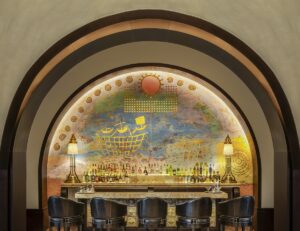
Image credit: Ralf Tooten / Marriott International
Just as any artist throughout history, artisans must be provided the opportunity to excel, allowing their creative vision to enhance the overall guest experience. We implemented this same approach when working on the St. Regis in Cairo. We provided a framework, walking the artist through our design intent and giving them the freedom to find inspiration to tell their own story. We sought out a local Egyptian artist, Ayman El Semary, who created his “Pink Sun” mural in the hotel’s Astor Bar, depicting the birth of a modern civilisation and symbolic moments of Egyptian history. This artwork is an homage to the women of Egypt, depicting the cross-cultural symbolic connection between the woman, the tree, the sun, and the full moon. El Semary’s distinctive work utilises a colour palette of indigo blue, cyan, green, oxidized yellow, pink and gold, symbolic of the sacred Pharaonic, Islamic, and Coptic civilisations. His work was also used in a recent lobby upgrade for the St. Regis, which conveys similar themes of heritage and modernity.
Recreated ceramic art from Fayoum Egypt, specifically what is referred to as the Fayoum Portraits, were also incorporated into the design. Some of the originals are a part of the Metropolitan Museum of Art’s permanent collection and were created in 100-150 AD in Greco-Roman Egypt. We worked with a ceramic artist from Fayoum to recreate these Portraits on display in the library. We also commissioned other objects from Foustat, a ceramics community in Cairo’s Old City. The same sentiment goes for the lighting created by Randa Fahmy, a locally respected metal artist who maintains the enduring metal and light shadow craft we know as an Egyptian/Arabian experience. Locally-manufactured Mother of Pearl designs, a traditional craft in a modern expression, can be found on the wall cladding on the main level of the hotel.
In the future, there’s no doubt that travellers will continue to seek out and engage in experiences that feel genuine and meaningful while simultaneously absorbing a better understanding of the world around them. It will be up to us, the architects and designers, to carry this strategy forward by immersing ourselves in history and culture to equip us with the knowledge needed to breathe life into breathtaking hospitality spaces. Whether that’s manifested through local partnerships with artisans and craftsmen, or translated through materials and floorplans, the goal as a designer is to shed light on the rich heritage that is so often disregarded in modern hospitality spaces.
As we move into this new era of post-pandemic travel, one thing is certain, and that is the need for authentic and immersive hospitality journeys.






